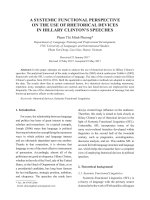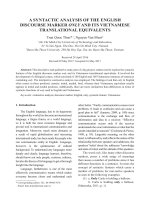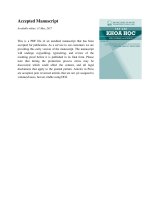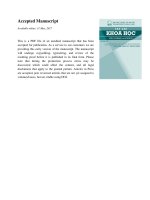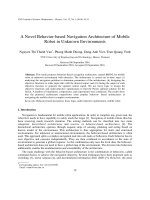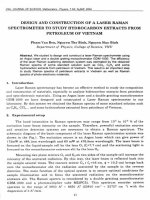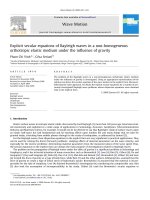DSpace at VNU: A Modified Survey of Reading Strategies (SORS) - a Good Instrument to Assess Students’ Reading Strategy Use
Bạn đang xem bản rút gọn của tài liệu. Xem và tải ngay bản đầy đủ của tài liệu tại đây (331.37 KB, 12 trang )
VNU Journal of Science: Foreign Studies, Vol. 32, No. 4 (2016) 52-63
A Modified Survey of Reading Strategies (SORS) - a Good
Instrument to Assess Students’ Reading Strategy Use
Nguyen Thi Bich Thuy*
College of Techniques, Economics and Trade, Phu Lam, Ha Dong, Hanoi, Vietnam
Received 25 August 2016
Revised 24 November 2016, Accepted 29 November 2016
Abstract: Reading comprehension is one of the most important factors in English language
learning for all students because it provides the basis for a substantial amount of learning in
education [1, 2]. Being aware of the importance of reading strategies and their impact on language
learning researchers all over the world have taken a lot investigations into this field. This paper is
an attempt to synthesize the most popular approaches to categorize reading strategies and proposes
an effective instrument to assess students’ reading strategy use.
Keywords: Reading strategies, reading strategy classification, reading comprehension, readers.
1. Introduction
making. Comprehension is enhanced when the
reader actively uses his/her cognitive strategies
such as comprehension strategies in the reading
process. In order to read effectively, readers
always try to draw selectively on a range of
strategies, which are determined by readers’
purpose, text type, and context [6].
Reading plays a crucial role in language
learning. It is one of the most important
language skills that students should be equipped
with. It is through reading that students access a
lot of information concerning the target
language and culture. For either ESL or EFL
learners (English as a second or foreign
language), it is the important skill to master in
order to ensure success in language learning [3].
After all, reading is the basis of instruction
in all aspects of language learning [4].
Erler & Finkbeiner [5] have proposed a
quite comprehensive definition of reading in
which they state that reading comprehension
has been conceived of as the result of complex
interactions between text, setting, reader,
reader’s background, reading strategies, first
and second language, and reader decision-
2. Reading strategies and their classifications
Reading strategies indicate how readers
conceive a task, what textual cues they attend
to, how they make sense of what they read, and
what they do when they do not understand [7].
Reading strategies refer to “the mental
operations involved when readers purposefully
approach a text and make sense of what they
read” [8].
Koda [9: 205] characterizes reading
strategies with three core elements: “deliberate,
goal/problem-oriented,
and
readerinitiated/controlled”. Sharing the similar view,
_______
Tel.: 84-989125552
Email:
52
N.T.B. Thuy / VNU Journal of Science: Foreign Studies, Vol. 32, No. 4 (2016) 52-63
Afflerbach et al., [10: 11] indicate that reading
skills are “automatic actions that result in
decoding, comprehension and fluency” while
reading strategies are “deliberate, goal-directed
attempts to control and modify the reader’s
efforts to decode text, understand words, and
construct meaning out of text”.
Researchers in reading strategy studies have
utilized different strategy types when
categorizing reading strategies. Numerous
classifications of reading strategies based on
contrasting criteria have been proposed by
different authors [7-14]. Each existing
classification system in and on itself involves
an implicit theory about the nature of reading
strategies. However, how best use of the
strategies presented by the authors can be made
depends on types of readers and their reading
purposes. Though using appropriate strategies
for leaning a language helps learners think and
process the target language in specific contexts
[15-17]. In fact, how many strategies are
available to learners to assist them in
second/foreign learning and how these
strategies should be classified are open to
debate [18]. Consequently, it is very puzzling
for teachers and researchers as to which
classification system to follow when they
con����������������������������������������������������������������������������������������������������������������������������������������������������������������������������������������������������������������������������������������������������������������������������������������������������������������������������������������������������������������������������������������������������������������������������������������������������������������������������������������������������������������������������������������������������������������������������������������������������������������������������������������������������������������������������������������������������������������������������������������������������������������������������������������������������������������������������������������������������������������������������������������������������������������������������������������������������������������������������������������������������������������������������������������������������������������������������������������������������������������������������������������������������������������������������������������������������������������������������������������������������������������������������������������������������������������������������������������������������������������������������������������������������������������������������������������������������������������������������������������������������������������������������������������������������������������������������������������������������������������������������������������������������������������������������������������������������������������������������������������������������������������������������������������������������������������������������������������������������������������������������������������������������������������������������������������������������������������������������������������������������������������������������������������������������������������������������������������������������������������������������������������������������������������������������������������������������������������������������������������������������������������������������������������������������������������������������������������������������������������������������������������������������������������������������������������������������������������������������������������������������������������������������������������������������������������������������������������������������������������������������������������������������������������������������������������������������������������������������������������������������������������������������������������������������������������������������������������������������������������������������������������������������������������������������������������������������������������������������������������������������������������������������������������������������������������������������������������������������������������������������������������������������������������������������������������������������������������������������������������������������������������������������������������������������������������������������������������������������������������������������������������������������������������������������������������������������������������������������������������������������������������������������������������������������������������������������������������������������������������������������������������������������������������������������������������������������������������������������������������������������������������������������������������������������������������������������������������������������������������������������������������������������������������������������������������������������������������������������������������������������������������������������������������������������������������������������������������������������������������������������������������������������������������������������������������������������������������������������������������������������������������������������������������������������������������������������������������������������������������������������������������������������������������������������������������������������������������������������������������������������������������������������������������������������������������������������������������������������������������������������������������������������������������������������������������������������������������������������������������������������������������������������������������������������������������������������������������������������������������������������������������������������������������������������������������������������������������������������������������������������������������������������������������������������������������������������������������������������������������������������������������������������������������������������������������������������������������������������������������������������������������������������������������������������������������������������������������������������������������������������������������������������������������������������������������������������������������������������������������������������������������������������������������������������������������������������������������������������������������������������������������������������������������������������������������������������������������������������������������������������������������������������������������������������������������������������������������������������������������������������������������������������������������������������������������������������������������������������������������������������������������������������������������������������������������������������������������������������������������������������������������������������������������������������������������������������������������������������������������������������������������������������������������������������������������������������������������������������������������������������������������������������������������������������������������������������������������������������������������������������������������������������������������������������������������������������������������������������������������������������������������������������������������������������������������������������������������������������������������������������������������������������������������������������������������������������������������������������������������������������������������������������������������������������������������������������������������������������������������������������������������������������������������������������������������������������������������������������������������������������������������������������������������������������������������������������������������������������������������������������������������������������������������������������������������������������������������������������������������������������������������������������������������������������������������������������������������������������������������������������������������������������������������������������������������������������������������������������������������������������������������������������������������������������������������������������������������������������������������������������������������������������������������������������������������������������������������������������������������������������������������������������������������������������������������������������������������������������������������������������������������������������������������������������������������������������������������������������������������������������������������������������������������������������������������������������������������������������������������������������������������������������������������������������������������������������������������������������������������������������������������������������������������������������������������������������������������������������������������������������������������������������������������������������������������������������������������������������������������������������������������������������������������������������������������������������������������������������������������������������������������������������������������������������������������������������������������������������������������������������������������������������������������������������������������������������������������������������������������������������������������������������������������������������������������������������������������������������������������������������������������������������������������������������������������������������������������������������������������������������������������������������������������������������������������������������������������������������������������������������������������������������������������������������������������������������������������������������������������������������������������������������������������������������������������������������������������������������������������������������������������������������������������������������������������������������������������������������������������������������������������������������������������������������������������������������������������������������������������������������������������������������������������������������������������������������������������������������������������������������������������������������������������������������������������������������������������������������������������������������������������������������������������������������������������������������������������������������������������������������������������������������������������������������������������������������������������������������������������������������������������������������������������������������������������������������������������������������������������������������������������������������������������������������������������������������������������������������������������������������������������������������������������������������������������������������������������������������������������������������������������������������������������������������������������������������������������������������������������������������������������������������������������������������������������������������������������������������������������������������������������������������������������������������������������������������������������������������������������������������������������������������������������������������������������������������������������������������������������������������������������������������������������������������������������������������������������������������������������������������������������������������������������������������������������������������������������������������������������������������������������������������������������������������������������������������������������������������������������������������������������������������������������������������������������������������������������������������������������������������������������������������������������������������������������������������������������������������������������������������������������������������������������������������������������������������������������������������������������������������������������������������������������������������������������������������������������������������������������������������������������������������������������������������������������������������������������������������������������������������������������������������������������������������������������������������������������������������������������������������������������������������������������������������������������������������������������������������������������������������������������������������������������������������������������������������������������������������������������������������������������������������������������������������������������������������������������������������������������������������������������������������������������������������������������������������������������������������������������������������������������������������������������������������������������������������������������������������������������������������������������������������������������������������������������������������������������������������������������������������������������������������������������������������������������������������������������������������������������������������������������������������������������������������������������������������������������������������������������������������������������������������������������������������������������������������������������������������������������������������������������������������������������������������������������������������������������������������������������������������������������������������������������������������������������������������������������������������������������������������������������������������������������������������������������������������������������������������������������������������������������������������������������������������������������������������������������������������������������������������������������������������������������������������������������������������������������������������������������������������������������������������������������������������������������������������������������������������������������������������������������������������������������������������������������������������������������������������������������������������������������������������������������������������������������������������������������������������������������������������������������������������������������������������������������������������������������������������������������������������������������������������������������������������������������������������������������������������������������������������������������������������������������������������������������������������������������������������������������������������������������������������������������������������������������������������������������������������������������������������������������������������������������������������������������������������������������������������������������������������������������������������������������������������������������������������������������������������������������������������������������������������������������������������������������������������������������������������������������������������������������������������������������������������������������������������������������������������������������������������������������������������������������������������������������������������������������������������������������������������������������������������������������������������������������������������������������������������������������������������������������������������������������������������������������������������������������������������������������������������������������������������������������������������������������������������������������������������������������������������������������������������������������������������������������������������������������������������������������������������������������������������������������������������������������������������������������������������������������������������������������������������������������������������������������������������������������������������������������������������������������������������������������������������������������������������������������������������������������������������������������������������������������������������������������������������������������������������������������������������������������������������������������������������������������������������������������������������������������������������������������������������������������������������������������������������������������������������������������������������������������������������������������������������������������������������������������������������������������������������������������������������������������������������������������anation above, an SORS
with some modification by adding two more
mentioned strategies might be recommended in
reading strategy research. Thirty two statements
grounded by thirty two strategies can be used as
the main part of a questionnaire to investigate
readers’ strategy use. The strategies are divided
into three categories proposed by Mokhtari and
Richard [14]. They are described as followings:
N.T.B. Thuy / VNU Journal of Science: Foreign Studies, Vol. 32, No. 4 (2016) 52-63
58
1. Global reading strategies (13 items
originally) refer to intentional, carefully
planned techniques by which learners monitor
or manage their reading. They can be thought of
as generalized or global reading strategies
aimed at setting the stage for the reading act
(for instance, setting purpose for reading,
previewing text content, predicting what the
text is about, etc.).
2. Problem-solving strategies (8 items
originally) are related to actions and procedures
that the readers use while working directly with
the text. These strategies are localized, focused
problem-solving or repair strategies used when
problems develop in understanding textual
information (for example, checking one’s
understanding upon encountering conflicting
No.
information,
re-reading
for
better
understanding, etc.).
3. Support strategies (9 items originally)
are a set of mechanisms intended to aid the
reader in comprehending the text such as using
a dictionary, taking notes, underling, or
highlighting textual information. These
strategies
involve
using
the
support
mechanisms or tools aimed at sustaining
responsiveness to reading (such as use of
reference materials like dictionaries and other
support systems) [15:4].
These three classes of strategies interact
with and support each other when used in the
process of constructing meaning from text.
Below is a proposed modified SORS.
Strategies
Global strategies
1
2
3
4
5
6
7
8
9
10
11
12
13
G.1 I have a purpose in mind when I read.
G.2 I think about what I know to help me understand what I read.
G.3 I take an overall view of the text to see what it is about before reading it.
G. 4. I think about whether the content of the text fits my reading purpose.
G.5 I review the text first by noting its characteristics like length and organization.
G I.6 When reading, I decide what to read closely and what to ignore.
G.7 I use tables, figures, and pictures in text to increase my understanding.
G.8 I use context clues to help me better understand what I am reading.
G.9 I use typographical features like bold face and italics to identify key information.
G.10 I critically analyze and evaluate the information presented in the text.
G.11 I check my understanding when I come across new information.
G.12 I try to guess what the content of the text is about when I read.
G.13 I check to see if my guesses about the text are right or wrong.
Problem Solving strategies
14
15
16
17
18
19
20
21
P.1 I read slowly and carefully to make sure I understand what I am reading.
P.2 I try to get back on track when I lose concentration.
P.3 I adjust my reading speed according to what I am reading.
P.4 When text becomes difficult, I pay closer attention to what I am reading.
P.5 I stop from time to time and think about what I am reading.
P.6 I try to picture or visualize information to help remember what I read.
P.7 When text becomes difficult, I re-read it to increase my understanding.
P.8 When I read, I guess the meaning of unknown words or phrases.
N.T.B. Thuy / VNU Journal of Science: Foreign Studies, Vol. 32, No. 4 (2016) 52-63
59
Support Strategies
22
S.1 I take notes while reading to help me understand what I read.
23
24
25
26
27
28
S.2 When text becomes difficult, I read aloud to help me understand what I read.
S.3 I underline or circle information in the text to help me remember it.
S.4 I use reference materials (e.g., dictionary) to help me understand what I read.
S.5 I paraphrase (restate ideas in my own words) to better understand what I read.
S.6 I go back and forth in the text to find relationship among ideas in it.
S.7 I summarize what I read to reflect on important information in the text
29
30
31
32
S.8 I ask myself questions I like to have answered in the text
S.9 When reading, I translate from English into my native language
S.10 I discuss what I read with others to check my understanding
S.11 When reading, I think about information in both English and my mother tongue
3.2. A pilot study
To check the compatibility of the scale and
the suitability of the strategies in the modified
classification, a pilot study on the sample of
107 cases who were students from three
universities in Hanoi, Vietnam, was conducted.
Of the 107 students, 44 were male and 63 were
female, majoring in accounting, administration
and technology.
Cronbach’s Alpha was used to check the
reliability of the scale inside which indicates the
degree of correlation among the variables in
each strategy group. Scale gain credibility when
Cronbach’s alpha is more than 0.6 and a
correlation between coefficient variables and
total is more than 0.3. The correlation between
coefficient variables and total presents the value
of a variable correlated with the average score
of the other variables in the same scale. The
higher this coefficient is the higher the
correlation between it and other variables in the
group is. The variables correlated between
variables and the total smaller than 0.3 are
considered as spam and removed [26].
When testing the reliability of the scale, one
bad variable was found out, named I think
about whether the content of the text fits my
reading purpose. This variable had a correlation
coefficient among other variables of less than
0.3 and when this variable was removed from
the model the Cronbach’s Alpha coefficient
significantly increased (from 0,816 to 0,819).
So this variable was removed to guarantee the
reliability of the measuring scale.
Another bad variable was also found I try to
picture or visualize information to help
remember what I read, which had a correlation
coefficient among other variables of less than
0.3 (=0,203). However, this strategy was useful
for many students. In addition, with this
variable the Cronbach’s Alpha also reached the
necessary reliability (=0.789), so this variable
was remained. A survey of reading strategies
with thirty one items categorized in three
subscales was proposed.
3.3. Main study
To test the reality and the generalization of
the proposed SORS, another study was
conducted on 928 students from 6 universities
in Hanoi (Hanoi University of Water
Resources, Banking Academy, Trade Union
University, Foreign Trade University, Hanoi
Open University, and Vietnam Military
Medical University). The students were diverse
in terms of gender, major, time length and
experiences in English learning including
reading comprehension proficiency, etc. The
participants aged from 20-22, majoring in
Economics, Technology, Finance/Banking,
Medicine, and Administrating are second or
third year students. They have completed their
60
N.T.B. Thuy / VNU Journal of Science: Foreign Studies, Vol. 32, No. 4 (2016) 52-63
general English course and are going to finish
their English for specific purposes programmes
in their university curricula. After the data
cleansing process the number of valid
participants was 781. The participants were
asked to fill in a questionnaire on English
reading strategy use which consisted of two parts:
- Part One was designed to gather the
information about individual characteristics of
the participants. It required the subjects to
supply their ethnographic data, such as gender,
age, time of English study, major, their selfassessment on English and reading proficiency.
- Part Two included the proposed SORS
mentioned above with thirty one statements
appropriate to thirty different strategies
categorized in three subscales applied in
reading comprehension.
For each questionnaire statement, five
alternative choices were provided. Participants
were asked to select one from among the
followings:
1 for Never or almost never true of me
2 for Usually not true of me
3 for Somewhat true of me
4 for Usually true of me
5 for Always or almost true of me
The higher the number that respondents
indicate applied to them, the more frequent the
use of the particular strategy was reflected.
After collecting the data, some tests were
conducted to determine the validity and
reliability of the SORS. Firstly, the assumption
No.
1
Subscale
Overviewing
2
3
Problem Solving
Supporting
4
Guessing
5
Information Dealing
of normality of the data collected was examined
with Skewness and Kurtosis. The results of the
tests revealed that the data were approximately
normally distributed, in terms of Skewness and
Kurtosis, with z-value were in the span of -1.96
to 1.96. Furthermore, a Shapiro-Wilk’s test with
p <0.05 [27] and a visual inspection of the
histograms, normal Q-Q plots and box plots
showed that the scores were also approximately
normally distributed [28]. So, the assumption of
normality for the data was tenable.
Secondly, the Cronbach’s Alpha score was
measured to examine the internal consistency of
reliability for the modified SORS with the
participants for this study. Cronbach’s Alpha
scores for the modified SORS for reading
EGAP texts were 0.926 (Corrected Item-Total
Correlation was 0.524) and for reading EGAP
texts were 0.932 (Corrected Item-Total
Correlation was 0.540), which proved that the
modified SORS was highly reliable [26].
Thirdly, Exploratory Factor Analysis (EFA)
was run to verify scale construction of the
strategy classification. The results of KMO and
Bartlett’s test of sphericity indicated a good
adequacy to use the data in a factor analysis
(KMO = 0.940; Sig <0.05) [29]. It was a
surprise that the result of rotated factor matrix
showed that the thirty one strategies were
categorized in five components, each of which
consisted of strategies with significant
correlation. Based on the meaning and
correlation of strategies of each component, the
researcher re-categorized the strategies into five
subscales with titles and usage as follows:
Usage
Used at the first stage of the reading process when the readers plan to
monitor or manage their reading.
Used when the readers meet difficulties while working directly with the text
Used when the readers need aids to understand the text. The aids may be
from reference materials or the readers’ own ways, or from other readers,
for better comprehension.
Used during reading process, when the readers want to guess the meaning
of the text without any aids
Used when the readers want to check their understanding of the read
information
N.T.B. Thuy / VNU Journal of Science: Foreign Studies, Vol. 32, No. 4 (2016) 52-63
61
At this stage, a full modified SORS with thirty one items categorized in five subscales should be
proposed as the followings:
No.
Strategies
OVERVIEWING STRATEGIES
1
2
3
4
5
6
I have a purpose in mind when I read.
I think about what I know to help me understand what I read.
I take an overall view of the text to see what it is about before reading it.
I review the text first by noting its characteristics like length and organization.
When reading, I decide what to read closely and what to ignore.
I use typographical features like bold face and italics to identify key
information.
PROBLEM DEALING STRATEGIES
7
8
9
10
11
12
13
I try to get back on track when I lose concentration.
I adjust my reading speed according to what I am reading.
When text becomes difficult, I pay closer attention to what I am reading.
I stop from time to time and think about what I am reading.
I read slowly and carefully to make sure I understand what I am reading.
When text becomes difficult, I re-read it to increase my understanding.
When text becomes difficult, I read aloud to help me understand what I read.
SUPPORTING STRATEGIES
14
15
16
17
18
19
20
21
I take notes while reading to help me understand what I read.
I underline or circle information in the text to help me remember it
I use reference materials (e.g., dictionary) to help me understand what I read.
When reading, I translate from English into my native language.
I paraphrase (restate ideas in my own words) to better understand what I read.
I go back and forth in the text to find relationship among ideas in it.
I summarize what I read to reflect on important information in the text
I discuss what I read with others to check my understanding
GUESSING STRATEGIES
22
23
24
25
I try to guess what the content of the text is about when I read.
I check to see if my guesses about the text are right or wrong.
When I read, I guess the meaning of unknown words or phrases.
I use context clues to help me better understand what I am reading.
INFORMATION DEALING STRATEGIES
26
27
28
29
30
31
I critically analyze and evaluate the information presented in the text.
I check my understanding when I come across new information.
I ask myself questions I like to have answered in the text
I use tables, figures, and pictures in text to increase my understanding.
I try to picture or visualize information to help remember what I read.
When reading, I think about information in both English and my mother
tongue.
1
2
3
4
5
62
N.T.B. Thuy / VNU Journal of Science: Foreign Studies, Vol. 32, No. 4 (2016) 52-63
The results of different necessary tests on
the modified SORS have confirmed its
reliability. The most significant thing of this
modified SORS is that it covers all appropriate
strategies proposed by previous authors and
helps readers decide what strategies to use at
each stage of the readers’ reading process. In
this way the strategies would be used
appropriately which helps reading gain the most
effectiveness. Any readers who want to assess
their own use of reading strategies themselves,
and any researchers who need to investigate
students’ strategy awareness can use this
modified SORS with a Likert scale as
proposed above.
4. Conclusion
The modified SORS has twofold usefulness.
Firstly, it can help teachers get information to
measure students’ reading strategy use and to
instruct them to comprehend a text in a strategic
way. Data obtained from the SORS can be used
as a means to monitor students to become
effective responsive readers. Secondly, students
can use the SORS as an instrument to increase
their own awareness of reading strategies. They
can evaluate themselves and adjust their way to
read more effectively. Application of good
strategies will help students become better
readers which motivate them to read more and
be more interested in language learning.
References
[1] Alvermann,
D.,
&
Earle,
J.
(2003).
Comprehension instruction. In A. P. Sweet & C.
Snow (Eds.).Rethinking reading comprehension
(pp. 12-30). New York: Guilford Press.
[2] Martin-Chang, S.Y., & Gould, O.N. (2008).
Revisiting print exposure: Exploring differential
links to vocabulary, comprehension and reading
rate. Journal of Research in Reading, 31, 273–
284.
[3] Alderson, C. (1984). Reading in a foreign
language. United States of America, New York.
Longman Inc.
[4] Mikulecky, B. S. & Beatrie (1990). A Short
Course in Teaching Reading Skills. Longman.
[5] Erler, L., & Finkbeiner, C. (2007). A review of
reading strategies: Focus on the impact of first
language. In A. D. Cohen & E. Macaro (Eds.),
Language learner strategies. Oxford, UK: Oxford
University Press.
[6] Wallace, C. (1992). Reading. Oxford University
Press.
[7] Block, E. (1986). The comprehension strategies of
second language readers. TESOL Quarterly,
20(3), 463-494.
[8] Brantmeier, C. (2002). Second language reading
strategy research at the secondary and university
levels:
Variations,
disparities,
and
generalizability. The Reading Matrix, 2(3), 1–13.
[9] Koda, K. (2005). Insights into Second Language
Reading: A Cross-linguistic Approach.. New
York: Cambridge University Press.
[10] Afflerbach, P., Pearson, P., & Paris, S. (2008).
Skills and strategies: their differences, their
relationships and why it matters. In: Mokhtari, K.,
Sheorey, R. (Eds.), Reading Strategies of Firstand Second-language Learners: See How They
Read. Christopher-Gordon Publishers, Inc.,
Norwood, MA.
[11] O'Malley, J., & Chamot, A. (1990). Learning
strategies in second language acquisition.
Cambridge: Cambridge University Press.
[12] Oxford, R. L. (1990). Language Learning
Strategies. What Every Teacher should know.
Boston. Heinle & Heinle Publishers.
[13] Anderson, N. J. (1991). Individual differences in
strategy use in second language reading and
testing. Modern Language Journal, 75, 460-472.
[14] Mokhtari, K., & Sheorey, R. (2002). Measuring
ESL students’ awareness of reading strategies.
Journal of Developmental Education, 25, 2-10.
[15] Chamot, A. U. (2005). Language learning strategy
instruction: Current issues and research. Annual
Review of Applied Linguistics, 25, 112–130.
[16] Cohen, A. D. (2007). Coming to terms with
language learner strategies: Surveying the experts.
In A. D. Cohen & E. Macaro (Eds.), Language
learner strategies: Thirty years of research and
practice (pp. 29-46). Oxford, England: Oxford
University Press.
[17] Oxford,R,.L. (2011). Teaching and researching
language learning stratgies. Pearson.Harlow. UK.
[18] Hsiao, T.Y. & Oxford, R. L. (2002). Comparing
theories of language learning strategies: A
N.T.B. Thuy / VNU Journal of Science: Foreign Studies, Vol. 32, No. 4 (2016) 52-63
[19]
[20]
[21]
[22]
[23]
confirmatory factor analysis. Modern Language
Journal, 86, 368–383.
Brown, A.L., & Palinscar, A.S., (1984).
Reciprocal Teaching of Comprehension Fostering
and Comprehension- Monitoring Activities.
Cognition and Instruction. 1(2),117-175.
Anderson, R. C., Hiebert, E. F., Wilkinson, I. A.
G., & Scott, J. (1985). Becoming a Nation of
Readers. Champaign, Ill.: National Academy of
Education and Center for the Study of Reading.
Kaylani, C. (1996). The influence of gender and
motivation on EFL learning strategy use in
Jordan, in R. Oxford (Ed.). Language learning
strategies around the world: Cross-cultural
perspectives. University of Hawaii, Honolulu,
75-88.
Mokhtari, K. & C. Reichard (2002).“Assessing
students’ metacognitive awareness of reading
strategies”. Journal of Educational Psychology 94:
249-259.
Nambiar, R. (2009). Learning strategy researchwhere are we now? The Reading Matrix, 9(2),
132-149.
63
[24] Alsheikh, N. (2011). Three Readers, Three
Languages, Three Texts: The Strategic Reading of
Multilingual and Multiliterate Readers. The
Reading Matrix, 11(1), 34-53.
[25] Monos, K. (2005). A study of the English Reading
Strategies of Hungarian University Students with
Implications for Reading Instruction in an
Academic Context. University of Debrecen,
Hungary.
[26] Nunnally & Burnstein (1994). Pschy Chometric
Theory. 3rd Edition. McGraw Hill.
[27] Shapiro, S. S., & Wilk, M. B. (1965). An analysis
of variance test for normality (complete samples).
Biometrika, 591-611.
[28] Cramer, D., & Howitt, D. L. (2004). The Sage
dictionary of statistics: a practical resource for
students in the social sciences. Sage.
[29] Hair &ctg (1998). Multivarate Data Analysis.
Prentice- Hall International.
SORS - một công cụ hiệu quả để đánh giá việc sử dụng
chiến lược đọc của sinh viên
Nguyễn Thị Bích Thủy
Trường Cao đẳng Kinh tế- Kỹ thuật Thương mại, Phú Lãm, Hà Đông, Hà Nội, Việt Nam
Tóm tắt: Đọc hiểu là một trong những yếu tố quan trọng nhất trong việc học tiếng Anh của sinh
viên bởi vì nó là cơ sở cho việc học tập lâu dài trong quá trình đào tạo [1, 2]. Nhận thức được tầm
quan trọng của các chiến lược đọc và tác động của chúng tới việc học tập ngôn ngữ, các nhà nghiên
cứu trên thế giới đã thực hiện rất nhiều khảo sát về lĩnh vực này. Bài viết này nhằm tổng hợp các cách
phân loại chiến lược đọc phổ biến nhất và đề xuất một công cụ hiệu quả để đánh giá việc sử dụng
chiến lược đọc của sinh viên.
Từ khóa: Chiến lược đọc, phân loại chiến lược đọc, đọc hiểu, người đọc.

